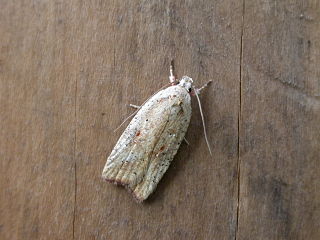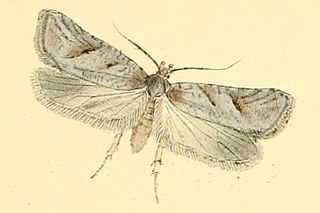
Thera variata, the spruce carpet, is a moth of the family Geometridae. It is found throughout Europe, North Asia and Japan. The common name spruce carpet is also used when referring to Thera britannica.

Epinotia tedella is a moth of the family Tortricidae. It is found in Europe.

Agonopterix arenella is a species of moth of the family Depressariidae. It is found in all of Europe, except the Iberian Peninsula.

Tetheella is a monotypic moth genus in the family Drepanidae described by Werny in 1966. Its single species, Tetheella fluctuosa, the satin lutestring, was described by Jacob Hübner in 1803. It is found from western Europe across the Palearctic to Kamchatka, Sakhalin Island, Korea and Japan.

Ochropacha is a monotypic moth genus in the family Drepanidae. The genus was first described by Hans Daniel Johan Wallengren in 1871. Its single species, Ochropacha duplaris, the common lutestring, was first described by Carl Linnaeus in 1761. It is found in China (Jilin), Russia, Japan, the Korean Peninsula and from Central Asia to Europe.

The gorse tip moth is a smallish moth species of the family Depressariidae.

Plutella porrectella is a moth of the family Plutellidae found in Europe, the Caucasus, southern Siberia and Asia Minor.

Depressaria daucella is a moth of the family Depressariidae. It is found in most of Europe, except most of the Balkan Peninsula. It is also found in North America.

Depressaria badiella is a moth of the family Depressariidae. It is found in most of Europe, Libya, the Caucasus and Mongolia.

Depressaria pulcherrimella is a moth of the family Depressariidae. It is found in most of Europe, except the Balkan Peninsula.

Depressaria ultimella is a moth of the family Depressariidae. It is found in most of Europe, except Spain, Norway, Finland, Lithuania, Switzerland, Italy and most of the Balkan Peninsula.

Exaeretia allisella is a moth of the family Depressariidae. It is found in most of northern and central Europe, Siberia, the Russian Far East, Mongolia and northern and central China.
Depressaria togata is a moth in the family Depressariidae. It was described by Lord Walsingham in 1889. It is found in North America, where it has been recorded from Montana, from British Columbia to Arizona and in Oregon and Washington.
Agonopterix taciturna is a moth in the family Depressariidae. It was described by Edward Meyrick in 1910. It is found in the Himalayas, the Russian Far East and Japan.
Depressaria chlorothorax is a moth in the family Depressariidae. It was described by Edward Meyrick in 1921. It is found in Asia Minor and Palestine.
Depressaria orthobathra is a moth in the family Depressariidae. It was described by Edward Meyrick in 1918. It is found in South Africa.
Depressaria panurga is a moth in the family Depressariidae. It was described by Edward Meyrick in 1920. It is found in South Africa.
Depressaria prospicua is a moth in the family Depressariidae. It was described by Edward Meyrick in 1914. It is found in South Africa.
Depressaria rhodoscelis is a moth in the family Depressariidae. It was described by Edward Meyrick in 1920. It is found in South Africa.
Epinotia subsequana, also known as the dark spruce moth, is a species of moth belonging to the family Tortricidae. It was described by the English entomologist, Adrian Hardy Haworth in 1811 and is native to Europe.










